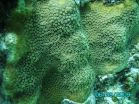(Press-News.org) COLUMBUS, Ohio—The future health of the world's coral reefs and the animals that depend on them relies in part on the ability of one tiny symbiotic sea creature to get fat—and to be flexible about the type of algae it cooperates with.
In the first study of its kind, scientists at The Ohio State University discovered that corals—tiny reef-forming animals that live symbiotically with algae—are better able to recover from yearly bouts of heat stress, called "bleaching," when they keep large energy reserves—mostly as fat—socked away in their cells.
"We found that some coral are able to acclimatize to annual bleaching, while others actually become more susceptible to it over time," said Andréa Grottoli, professor in the School of Earth Sciences at Ohio State. "We concluded that annual coral bleaching could cause a decline in coral diversity, and an overall decline of coral reefs worldwide."
The study, which appears in the July 9 online edition of Global Change Biology, indicates that some coral species will almost certainly decline with global climate change, while others that exhibit large fat storage and flexibility in the types of algae they partner with will stand a better chance of enduring repeated rounds of stress as oceans get hotter.
It also suggests that the most adaptable species would make good targets for conservation efforts because they are most likely to survive.
"If we conserve reefs that contain coral species with these survival traits, then we're hedging our bets that we might be able to preserve those reefs for an extra decade or two, buying them enough time to acclimatize to climate change," Grottoli said.
Corals are essentially colorless; the brilliant browns, yellows, and greens that we associate with them are actually the colors of algae living inside the corals' animal cells. That's why, when stressed coral dump most of the algae from their cells, their bodies appear pale, or "bleached."
Bleached corals can recover by growing more algae or acquiring new algae once water temperatures return to normal. This research shows that corals' ability to switch the type of algae that they internally grow has a large effect on their recovery.
But if corals don't recover and reefs die, thousands of fish species and other sea creatures lose their habitat.
Normally, bleaching is a rare event. But by 2025, Caribbean waters are expected to be hot enough that the coral living there will be stressed to the point of bleaching once a year. The rest of the tropics are expected to experience annual bleaching by 2050.
Previous studies have only followed coral through one bleaching event, or through two events several years apart. So Grottoli and her team tested what would happen if they subjected some common Caribbean corals to bleaching for two years in a row.
Corals can supplement their diet by eating plankton, but they get most of their energy from their symbiotic relationship with algae. The algae get nutrients from the coral, and the corals get to siphon off sugars that the algae produce in photosynthesis. Like humans, corals can store excess energy as fat.
Two key survival strategies emerged in this study: the most resilient corals stored up fat reserves in times of plenty, and were willing to switch to a new dominant algal type in order to gather food in times of stress. Corals that didn't store fat or were stuck with their algal partner didn't fare as well.
And species that bounced back from one round of bleaching didn't necessarily bounce back a second time.
"We found that the research on single bleaching events is misleading," Grottoli said. "Species that we think are resilient to temperature stress are actually susceptible and vice versa when stressed annually."
Grottoli and her colleagues tested three corals from Puerto Morelos Reef National Park, off the coast of Mexico. Two years in a row, they plucked samples of Porites divaricata, Porites astreoides, and Orbicella faveolata—more commonly known as finger coral, mustard hill coral, and boulder coral—from the ocean floor, and placed them in warm water tanks in an outdoor lab until the corals bleached. Both times, the researchers returned the corals to the ocean to let them recover. They measured several indicators of how well the different species recovered, including the number and type of algae present in the corals' cells and remaining energy reserve.
The mustard hill coral kept lower fat reserves, and partnered with only one algal species. It recovered from the first round of bleaching but not the second. The boulder coral kept moderate fat reserves, but partnered with six different algae and changed between dominant algal types following each bleaching. It recovered from both rounds of bleaching, though it's growth slowed.
The real winner was the finger coral, which switched completely from one algal partner type to another over the course of the study, and had the largest fat reserves—47 percent higher than the boulder coral or mustard hill coral. The finger coral was barely even affected by the second bleaching and maintained a healthy growth rate.
The bottom line: as some species adapt to climate change and others don't, there will be less diversity in reefs, where all the different sizes and shapes of coral provide specialized habitats for fish and other creatures. Interactions among hosts, symbionts, predators and prey would all change in a domino effect, Grottoli said. Reefs would be more vulnerable to storms and disease in general.
It sounds like a bleak picture.
"We're actually a bit optimistic, because we showed that there's acclimation in a one-year window, that it's possible," she said. "In two of our three coral species, we have recovery in six weeks. The paths they took to recovery are different, but they both got there."
INFORMATION:
Coauthors on the study included Grottoli's former graduate students Stephen Levas, Verena Schoepf, and Justin Baumann; Ohio State research associate Yohei Matsui; and Mark Warner of the University of Delaware and his graduate students Matthew Aschaffenburg and Michael McGinley.
This research was funded by the National Science Foundation.
For corals adapting to climate change, it's survival of the fattest -- and most flexible
Study suggests best targets for environmental conservation
2014-07-09
ELSE PRESS RELEASES FROM THIS DATE:
Mode of delivery following a perineal tear and recurrence rate in subsequent pregnancies
2014-07-09
There is an increased risk of severe perineal tearing during childbirth in women who had such a tear in a previous delivery, suggests a new study published today (9 July) in BJOG: An International Journal of Obstetrics and Gynaecology (BJOG).
This study, investigates among women who have had a third or fourth degree perineal tear, the mode of delivery in subsequent pregnancies and the recurrence of severe perineal tears.
Most women tear to some extent during childbirth and in some women the tear may be more extensive. A third degree tear extends downwards from the ...
Fun or exercise?
2014-07-09
Think of your next exercise workout as a "fun run" or as a well-deserved break, and you'll eat less afterward. Think of it as exercise or as a workout and you'll later eat more dessert and snacks to reward yourself.
These new findings from the Cornell Food and Brand Lab study involved two studies where adults were led on a 2 km walk around a small lake and were either told it was going to be an exercise walk or a scenic walk. In the first study, 56 adults completed their walk and were then given lunch. Those who believed they had been on an exercise walk served and ...
New plant species from the heart of Texas
2014-07-09
SALT LAKE CITY, July 9, 2014 – Collectors found the first two specimens of the prickly plant in 1974 and 1990 in west Texas. Then, for two decades, the 14-inch-tall plant was identified wrongly as one species, then another and then a third.
Now – after a long search turned up a "pathetic, wilted" third specimen – a University of Utah botanist and her colleagues identified the spiny plant as a new, possibly endangered species and named it "from the heart" in Latin because it was found in Valentine, Texas, population 134 in 2010.
Most new plant species are found in the ...
Minimally invasive surgery underused at many US hospitals
2014-07-09
Hospitals across the country vary substantially in their use of minimally invasive surgery, even when evidence shows that for most patients, minimally invasive surgery is superior to open surgery, a new study shows. The finding represents a major disparity in the surgical care delivered at various hospitals, the study's authors say, and identifies an area of medicine ripe for improvement.
"Some surgeons specialize in complex open operations, and we should endorse that expertise," says Marty Makary, M.D., M.P.H., a professor of surgery at the Johns Hopkins University School ...
Carbon monoxide predicts 'red and dead' future of gas guzzler galaxy
2014-07-09
Astronomers have studied the carbon monoxide in a galaxy over 12 billion light years from Earth and discovered that it's running out of gas, quite literally, and headed for a 'red and dead' future.
The galaxy, known as ALESS65, was observed by the Atacama Large Millimeter Array (ALMA) in 2011 and is one of less than 20 known distant galaxies to contain carbon monoxide.
Dr Minh Huynh from The University of Western Australia node of the International Centre for Radio Astronomy Research (ICRAR) led the team on their search for galactic carbon monoxide in work published ...
Health-care worker hand hygiene rates increase three-fold when auditors visible
2014-07-08
Hand hygiene rates were found to be three times higher when auditors were visible to healthcare workers than when there were no auditors present, according to a study in a major Canadian acute care hospital.
The study, titled, "Quantification of the Hawthorne effect in hand hygiene compliance monitoring using an electronic monitoring system: a retrospective cohort study," published today on-line in the BMJ Quality & Safety Journal, by first author Dr. Jocelyn Srigley, who did the study as part of her Master's thesis while a Clinical Fellow in Infection Prevention and ...
LJI develops new approach to identify genes poised to respond in asthma patients
2014-07-08
SAN DIEGO – July 8, 2014 In a study published yesterday in the scientific journal Nature Immunology, a group at the La Jolla Institute (LJI) led by Pandurangan Vijayanand, Ph.D. identify new genes that likely contribute to asthma, a disease that currently affects over 200 million people world wide.
An organism's genetic material, also known as its genome, can be divided into small sections or 'neighborhoods.' Scientists can determine which genetic neighborhoods in a cell are active, or primed for gene production, by looking for a marker on the genome called an enhancer. ...
Astronomers bring the third dimension to a doomed star's outburst
2014-07-08
VIDEO:
NASA Goddard astrophysicists Ted Gull and Tom Madura discuss Eta Carinae and their new model of the Homunculus Nebula, a shell of gas and dust ejected during the star's mid-19th...
Click here for more information.
In the middle of the 19th century, the massive binary system Eta Carinae underwent an eruption that ejected at least 10 times the sun's mass and made it the second-brightest star in the sky. Now, a team of astronomers has used extensive new observations to create ...
NASA's SDO spots a summer solar flare
2014-07-08
The sun emitted a mid-level solar flare, peaking at 12:20 p.m. EDT on July 8, 2014, and NASA's Solar Dynamics Observatory captured images of the event. Solar flares are powerful bursts of radiation. Harmful radiation from a flare cannot pass through Earth's atmosphere to physically affect humans on the ground, however -- when intense enough -- they can disturb the atmosphere in the layer where GPS and communications signals travel.
To see how this event may affect Earth, please visit NOAA's Space Weather Prediction Center at http://spaceweather.gov, the U.S. government's ...
NASA-JAXA's new precipitation satellite sees first Atlantic hurricane
2014-07-08
VIDEO:
The animation begins with global infrared data showing the progression of the storm as it forms into a hurricane. Then GPM flies overhead measuring rain rates on the ground. GPM's...
Click here for more information.
The Global Precipitation Measurement (GPM) Core Observatory flew over Hurricane Arthur five times between July 1 and July 5, 2014. Arthur is the first tropical cyclone of the 2014 Atlantic hurricane season.
GPM is a joint mission between NASA and the Japan ...
LAST 30 PRESS RELEASES:
Low daily alcohol intake linked to 50% heightened mouth cancer risk in India
American Meteorological Society announces Rick Spinrad as 2026 President-Elect
Biomass-based carbon capture spotlighted in newly released global climate webinar recording
Illuminating invisible nano pollutants: advanced bioimaging tracks the full journey of emerging nanoscale contaminants in living systems
How does age affect recovery from spinal cord injury?
Novel AI tool offers prognosis for patients with head and neck cancer
Fathers’ microplastic exposure tied to their children’s metabolic problems
Research validates laboratory model for studying high-grade serous ovarian cancer
SIR 2026 delivers transformative breakthroughs in minimally invasive medicine to improve patient care
Stem Cell Reports most downloaded papers of 2025 highlight the breadth and impact of stem cell research
Oxford-led study estimates NHS spends around 3% of its primary and secondary care budget on the health impacts of heat and cold in England
A researcher’s long quest leads to a smart composite breakthrough
Urban wild bees act as “microbial sensors” of city health.
New study finds where you live affects recovery after a hip fracture
Forecasting the impact of fully automated vehicle adoption on US road traffic injuries
Alcohol-related hospitalizations from 2016 to 2022
Semaglutide and hospitalizations in patients with obesity and established cardiovascular disease
Researchers ‘listen in’ to embryo-mother interactions during implantation using a culture system replicating the womb lining
How changing your diet could help save the world
How to make AI truly scalable and reliable for real-time traffic assignment?
Beyond fragmented markets: A new framework for efficient and stable ride-pooling
Can shape priors make road perception more reliable for autonomous driving?
AI tracks nearly 100 years of aging research, revealing key trends and gaps
Innovative techniques enable Italy’s first imaging of individual trapped atoms
KIER successfully develops Korea-made “calibration thermoelectric module” for measuring thermoelectric device performance
Diversifying US Midwest farming for stability and resilience
Emphasizing immigrants’ deservingness shifts attitudes
Japanese eels, climate change, and river temperature
Pusan National University researchers discover faster, smarter heat treatment for lightweight magnesium metals
China’s 2024 Gastroenterology Report: marked progress in endoscopy quality and disease management
[Press-News.org] For corals adapting to climate change, it's survival of the fattest -- and most flexibleStudy suggests best targets for environmental conservation








